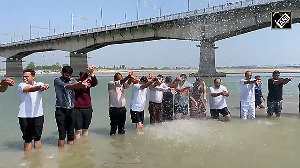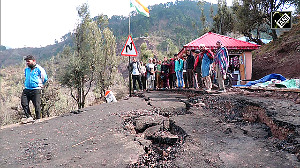It is distressing and alarming that communal tension is rising over the decision of the Jammu and Kashmir state government to transfer a little less than 40 hectares of land to the Sri Amarnathji Shrine Board to enable the latter to provide accommodation facilities to the thousands of Hindu pilgrims who visit the Amarnath shrine every summer. One cannot expect separatist and militant outfits in Jammu and Kashmir to make a sober and mature appraisal of the larger issues at stake. It is the attitude of mainstream political parties that is most disappointing and worrying.
The specious grounds for the the Peoples Democratic Party's objections are that the implementation of the decision of the state government would change the "eco-cultural character" of the state. What is the nature of this eco-cultural character of Jammu and Kashmir that is so fragile that it cannot survive the transfer of a small tract of land? Does the Kashmir valley have only a "Muslim" character? What happened to the much-touted Kashmiriyat? Or is that a politically correct platitude that has become an inconvenience to be ignored now that most of the Kashmiri Pandits have been hounded out of their homes in the Valley to Jammu, Delhi and elsewhere in India? Kashmiri politicians owe it to the rest of India to clarify their position on this issue.
To my mind, whether or not the land in question should be transferred to the SASB is only a technical question, not the heart of the issue. The more important thing is whether the state government feels that it has an obligation to improve the facilities that would make the pilgrimage of thousands of Hindu devotees more secure and more comfortable. For centuries pilgrims have been making the arduous trip to Amarnath cave without the benefit of any facilitation by the state. They relied on the local people for food, accommodation and other facilities. They lived in tents. But a caring State in independent India can and should do more.
It would be instructive to see what the Government of India does for Haj pilgrims visiting Mecca and Medina. The government is, in the words of External Affairs Minister Pranab Mukherjee, "committed to ensure that the best possible arrangements are put in place for the comfort and well-being of Indian pilgrims to facilitate their sacred pilgrimage." The "welfare and well-being of Haj pilgrims," he says, "is always a matter of utmost concern to the government."
In keeping with these public policy statements, the Government of India makes elaborate arrangements for the welfare of Haj pilgrims and strives to improve the facilities provided to them every year. That is how it should be. The Government of India, and the ministry of external affairs in particular, deserves credit for providing perhaps the best arrangements that any government makes for their Haj pilgrims.
And what exactly does the Government of India do? For starters, it provides an airfare subsidy to about 100,000 pilgrims selected by the Haj Committee of India who go for Haj annually. Pilgrims pay only Rs 12,000 for their air travel. This figure has remained unchanged for at least a decade or more.
According to official figures, this subsidy was Rs 280 crores in 2006, or about Rs 28,000 per pilgrim. Today, with rising fuel prices, this figure would have gone up to Rs 350-400 crores. Although there is a 2006 Allahabad high court judgment ruling against this subsidy, it continues to be given because the government got the Supreme Court to pass a stay order.
Add to this the losses suffered by Air India, and the inconvenience to passengers because its planes are diverted to carry Haj pilgrims. For the convenience of pilgrims, charter flights are operated directly from 16 airports in India to Saudi Arabia. Returning pilgrims can transport 10 litres of holy Zam Zam water with them free of cost. At Delhi airport there is a separate Haj terminal. To improve the comfort of pilgrims, Air India has been advised to use wide-body jets in future for their Haj flights.
Great attention and care to Haj matters is given at the highest levels of government. The United Progressive Alliance government has successfully lobbied with the Saudi government to increase the quota for pilgrims from India, as a result of which the annual quota has increased by 38,000 over the last four years. It will go up by a further 3,000 or so this year because of the exertions of External Affairs Minister Pranab Mukherjee during his visit to Saudi Arabia in April this year.
There is a separate Haj cell in the ministry of external affairs. The Haj Committee of India has its own premises in Mumbai. Similarly the State Haj Committees have their own premises in various other Indian cities. These facilities have been built on land provided by the state governments.
Very high priority is given to Haj matters in the mandate given by the government to both the Indian ambassador in Riyadh and the Indian consul general in Jeddah. Every government in Delhi has ensured that only Muslims are appointed to these posts, a practical decision intended to facilitate their travel to Mecca and Medina, where non-Muslims are not allowed. There is also a separate consul for Haj matters in the Indian consulate general in Jeddah.
Accommodation in Mecca and Medina is decided keeping in mind the need to provide maximum convenience and comfort to the pilgrims. Typically, all accommodation has lifts, telephones, running water, electricity and telephone at the minimum. There is total computerisation of pilgrim location and movement. During Haj, a large contingent of seasonal local staff, supervisors, data entry operators, as well as drivers and messengers (whose job is to round up and bring home safely elderly pilgrims who may have got lost) is appointed by the consulate general of India, Jeddah, during the Haj period.
For Haj 2007, a contingent of 115 doctors (including 63 specialists with post-graduate degrees) and 141 nurses and other para-medical staff, 3 coordinators, 46 assistant Haj officers, 165 Haj assistants and 186 Khadimul Hujjaj were sent from India on short-term deputation to Saudi Arabia. Special attention is given to medical facilities for the pilgrims.
Some of the facilities provided by the government are: arrangements for polio, meningitis and influenza vaccinations for pilgrims before departure; a 75-bed hospital and 12 branch offices-cum-dispensaries in Mecca; a 15-bed hospital and 6 branch offices-cum-dispensaries in Medina; three medical teams at Jeddah airport to provide medical care round the clock to Haj pilgrims; 17 ambulances in Mecca and Medina; supply of medicines, medical supplies and critical medical equipment from India. All this adds up to the total money spent by the government to facilitate a hassle-free Haj pilgrimage each year for tens of thousands of Muslims from India.
Perhaps our self-righteous and petty Kashmiri politicians in India's only Muslim-majority state should reflect over these facts and tell us whether they think it is at least their moral if not political obligation to be more caring and sensitive to Hindu pilgrims visiting Amarnath. If we can do so much for Indians going on a pilgrimage abroad, should we not be able to do as much if not better for pilgrims at home?
For a start, should not the Jammu and Kashmir government at least try to match the facilities given to pilgrims to Vaishno Devi shrine, which is located in the same state? And is it too much to expect our politicians and other "secular" leaders to be a bit more courageous and vocal in trying to knock some sense into the heads of shortsighted and irresponsible Kashmiri politicians?
As those in power, both in Delhi and Srinagar, ponder over this matter, the litmus test has to be whether the decision finally taken adds to the comfort and convenience of the pilgrims.
Indian citizens and taxpayers deserve honest answers to the questions posed above.






 © 2025
© 2025